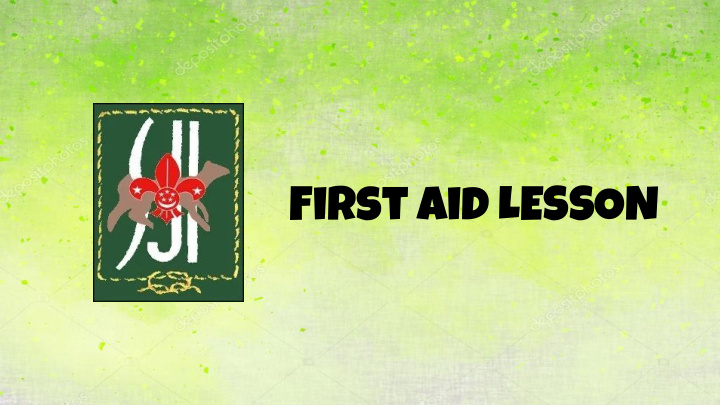



First Aid LESSON
Bandaging
Bandaging Materials needed: 1. Triangular bandage 2. Crepe bandage + pins 3. Gauze (padding) Folding a triangular bandage:
Bandaging Terminology for body parts: 1. Top of head 2. Forehead 3. Eye 4. Palm 5. Forearm 6. Elbow 7. Collarbone General rule: 1. Barrel to face upwards. 2. Fracture & dislocation = Immobilise & stabilise. 3. Bleeding = Elevate.
Bandaging Elevated arm sling: 1. To ensure hand is above heart level. 2. To immobilise.
Bandaging Open arm sling: 1. To ensure elbow is comfortably positioned at a 90 o angle. 2. To immobilise.
Bandaging (Fracture) Collarbone fracture: 1. Elevated arm sling. 2. Immobilise with broad bandage. Elbow fracture (Can bend), forearm fracture or shoulder dislocation: 1. Open arm sling. 2. Immobilise with broad bandage. Elbow fracture (Cannot bend): 1. Three broad bandages; 1 above elbow, 2 below elbow 2. Optional cushioning at injured elbow 3. Strong immobilisation Note: Picture shows 2 only, but 3 is recommended.
Bandaging (Fracture) Finger fracture: 1. Crepe bandage to cover all the fingers. 2. Elevated arm sling. 3. Immobilise with broad bandage. Rib fracture: 1. Padding pressed by elbow. 2. Broad bandage to secure padding. 3. Elevated arm sling. 4. Immobilise with broad bandage.
Internal Bleeding
Internal Bleeding Definition: 1. Known as contusions or bruises. 2. Bleeding internally caused by a fracture or a blow from blunt object. 3. No obvious blood losses. Steps: Signs & Symptoms: 1. Ice the bruise with indirect ice/ice pad. 1. Swelling & discolouration 2. Let nothing be of contact with the bruise. 2. Rapid/ weak pulse 3. Possible shocks 4. Vomiting/Coughing out blood 5. Bleeding from openings (eg. Mouth)
Blisters
Blisters Steps to Treat: 1. Cool: Flush blistered area with cool water for at least 10 mins or until pain is relieved. 2. Constrictor: Remove any constrictors from blistered area (watches, bracelets) before injured area starts to swell. 3. Cover: Cover blistered area with kitchen film / clean plastic bag 4. Consult: Seek medical advice.
Bee Stings
Bee Stings Steps to Treat: 1. Reassure the casualty 2. Use the edge of a card (credit card, EZ-Link etc) to brush or scrape the stinger out of the skin. 3. Raise affected area and apply a cold compress for at least 20 mins to provide mild relief. 4. Monitor vital signs and seek medical attention. DON’T USE TWEEZERS AS IT WILL INJECT MORE VENOM INTO BODY!
SRIC Challenge
Scenario On 8 August 2016, John was jogging during a 3.6 km cross-country race in Sengkang Riverside Park when a beehive fell from a tree. He was then chased by a swarm of bees. Immediately, he started to run away but received a bee sting on his left arm. While running, he tripped on a root and fell, bruising both his shins and fracturing his left collarbone.
Recommend
More recommend